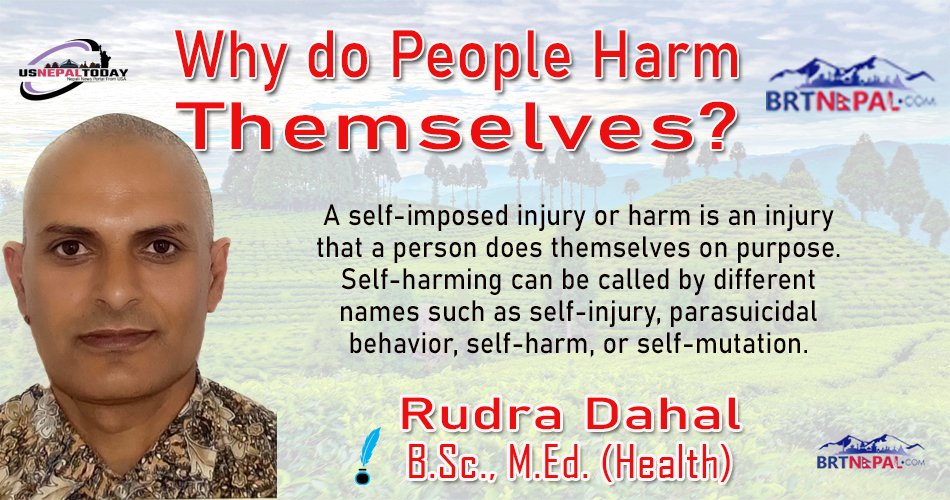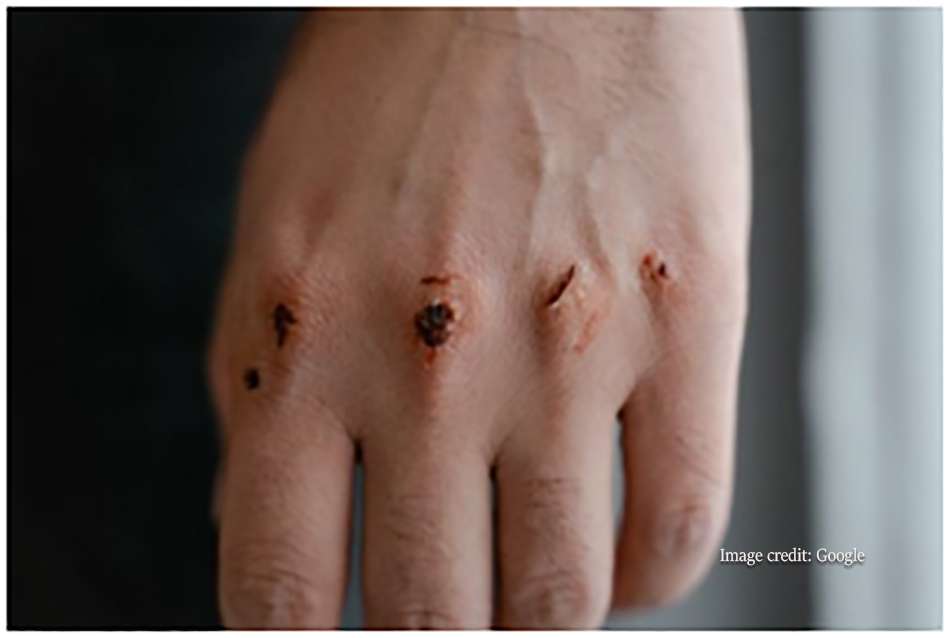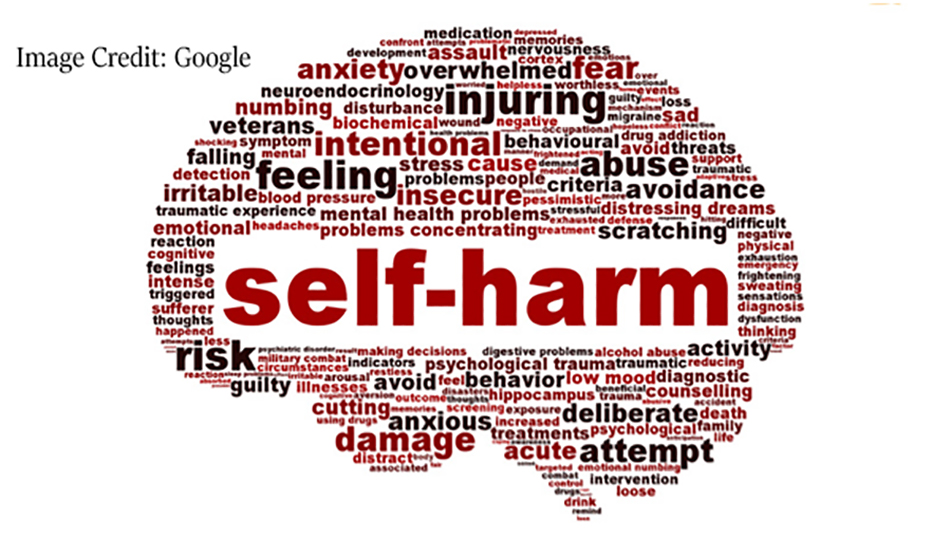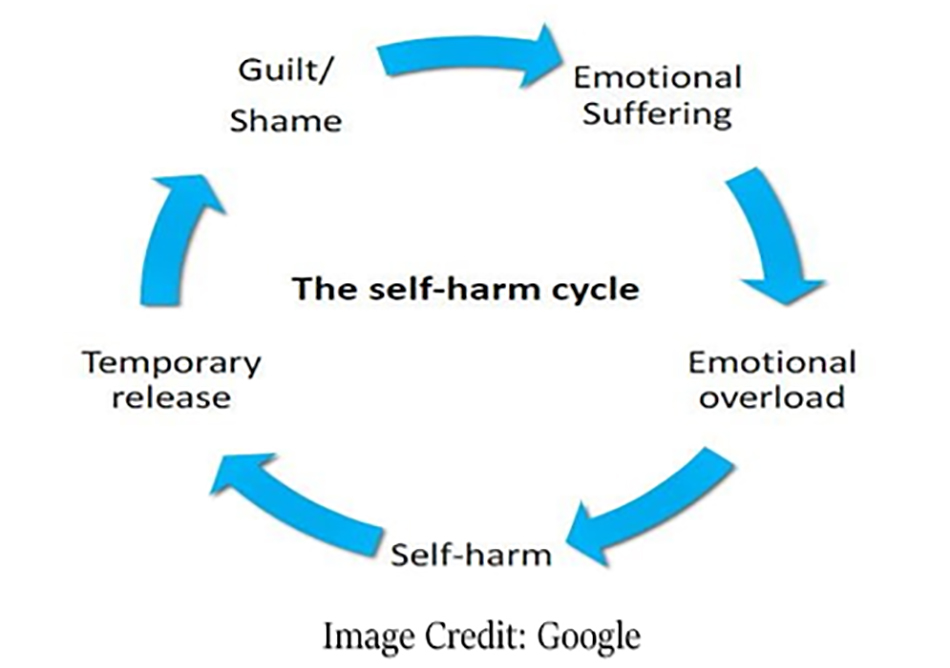
A self-imposed injury or harm is an injury that a person does themselves on purpose. Self-harming can be called by different names such as self-injury, parasuicidal behavior, self-harm, or self-mutation. Those people usually injure their arms, hands, legs, thigh, or torso as these are the parts that have easy access, and they can hide them easily with their clothes. Some people injure their scalp as they can hide the wound with the hair or hat.

According to Mental Health America, the common methods of self-injuries are:
Burning (15-35) %
Head Banging (21-44) %
Skin cutting (70-90) %

Most people who have driven to self-harm uses more than one method. Other than aforementioned, self-inflicted consists of:
• Hair pulling,
• Playing with healing would,
• Scratching,
• Inserting objects in body openings (nose, ear, mouth),
• Punching,
• Hitting,
• Intentionally exposing with toxins,
• Jumping (from high walls, heights, or dangerous areas),
• Drinking harmful liquids (detergent, body spray, insect killer).

Why do people do self-harming?
The reason for self-harming is complex. Misunderstanding, isolation, rejection, loneliness, family problems, and feeling threatened are apparent reasons for self-inflicted injury. Moreover, many people do these types of behaviors to cope with difficult situations such as severe pain. Many people attempt it to address their difficult circumstances, such as fear, shame, guilt, anger, and sadness. To make it easy, people self-harm to:
• Express the pain they are intentionally feeling, particularly if they struggle or are unable to express through words,
• Communication distress,
• Escaping from anguish,
• Distract themselves from painful emotions or memories,
• Escaping a situation that is unfavorable for them,
• Punish themselves for their perceived emotions or perceived failures,
• Changing other people’s behavior,
• Seeking help or attention.
 Who are vulnerable?
Who are vulnerable?
Self-injury is more common among teenagers and young adults in comparison of other age groups. According to Mental Health America, approximately 15% of teenagers, 17-35% of college students, and up to 40% of adults self-harm in the United States of America. People who have self-harming tendencies may experience bullying, academic pressure or failure, life tragedy, or unsuccessful life. Some groups who are vulnerable are:
1. Lesbian, Gay, and Bisexual: People who belongs to a sexual minority like Lesbian, Gay, or Bisexual are more prone to self-harm. Self-harming is directly related to violence, harassment, and discrimination too.
2. People with mental health conditions: Self-harm is a sign of mental health conditions. It can be manifestation of self-loathing or coping with severe feelings caused by the mental health condition. People with any mental health status can self-harm to them, but the person who has obsessive thoughts or compulsive behavior is mainly associated with it that includes:
• Substance abuse disorder
• Anxiety and depression
• Obsessive-compulsive disorder
• Eating disorder
• Post-traumatic disorder
How do know people have self-harming tendencies?
There are some signs we can see with the person who harms self could be:
• Always covering arms and legs even in the hot weather
• Having unexplained scars
• Frequent injures, cuts, bruise, burns, bites, or broken skins and bones
• Difficult in schoolwork, personal tasks, or relationships
• Showing extreme anger or sadness
• Low self-esteem
• Desire to punish self
• Developing different mental health conditions like eating disorders or substance abuse
How to prevent/manage self-harm?
It is possible to stop self-harming by applying the following measures:
1. Reach out for help: talk to trusted friends or family members about feelings or experience that are painful. If it is not possible to talk to them, then talk to schoolteacher, nurse, family doctor, counselor, or trusted community members. If talking is not feasible, write an email, a letter, or a diary.
2. Find professional help: It is always beneficial to seek professional assistance to solve the problem.
3. Remove self-harming equipment out of reach: It is wise to keep those items out of access of the person who uses them to harm themselves. For instance, keep sharp items, hazardous liquids, and other items locked (keep them securely).
4. Use of distraction techniques: Watching TV or movies in a group, playing with animals, calling a friend, engaging in social activities, exercising, walking, etc.
5. Releasing pent up feelings: When feeling painful situations/emotions- try alternate ways to express or release them by:
• Crying,
• Shouting or screaming,
• Scribbling or ripping up papers,
• Writing or talking to somebody to vent feelings.
6. Use of temporary substitutes: Some individual finds it helpful to try temporary and safe substitutes:
• Gently snapping an elastic band on the wrist,
• Rubbing an ice cube on the skin,
• Drawing on the skin where a person would like typically to injure the part.
7. Not leaving your child (ren) alone for a long time.
In conclusion, self-hurting is a behavioral problem which can be seen at any age group. People with sexual minority and grieving from mental health issues are prone for this problem. Parents or guardians should keep in mind that if the typical behavior changes to their family members, they need to find out what is going on with them. This issue can be addressed by listening to your children, providing love, affection, and equal opportunities, and in later stages seeking professional help.
 वरिष्ठ अभिनेता कृष्ण मल्ल नेपाल फिल्म सोसाइटीको अध्यक्षमा निर्विरोध निर्वाचित
वरिष्ठ अभिनेता कृष्ण मल्ल नेपाल फिल्म सोसाइटीको अध्यक्षमा निर्विरोध निर्वाचित
 समष्टिगत विषयवस्तुको चित्रण ‘चियर्स’ कथासङ्ग्रह
समष्टिगत विषयवस्तुको चित्रण ‘चियर्स’ कथासङ्ग्रह
 अनेसास कोलोराडो च्याप्टरको अध्यक्षमा किरण अधिकारी
अनेसास कोलोराडो च्याप्टरको अध्यक्षमा किरण अधिकारी
 सुनको मूल्य एकैदिन तोलामा २२ सयले घट्यो
सुनको मूल्य एकैदिन तोलामा २२ सयले घट्यो
 ‘पूर्णबहादुरको सारङ्गी’ बन्यो सबैभन्दा धेरै कमाउने चलचित्र, १४ दिनमा २७ करोड कमायो
‘पूर्णबहादुरको सारङ्गी’ बन्यो सबैभन्दा धेरै कमाउने चलचित्र, १४ दिनमा २७ करोड कमायो
 निर्देशक/कलाकार माओत्से गुरुङसँग “अग्निदहन” फिल्मलाई लिएर गरिएको छोटो कुराकानी
निर्देशक/कलाकार माओत्से गुरुङसँग “अग्निदहन” फिल्मलाई लिएर गरिएको छोटो कुराकानी
 गोपी मैनालीको विशृङ्खलित सपनाले देखाएको स्वप्निल सार
गोपी मैनालीको विशृङ्खलित सपनाले देखाएको स्वप्निल सार